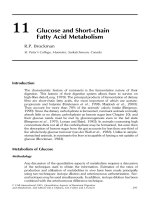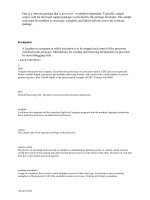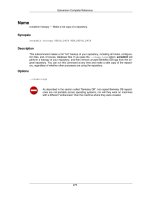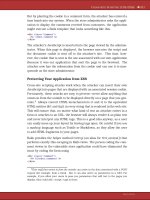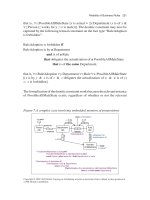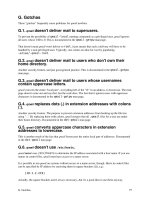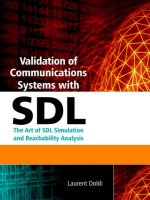Validation of Communications Systems with SDL phần 9 pptx
Bạn đang xem bản rút gọn của tài liệu. Xem và tải ngay bản đầy đủ của tài liệu tại đây (239.03 KB, 31 trang )
232 Validation of Communications Systems with SDL
A. In the Simulator, press on the button Verify
B. In the Verifying window, press on Limit a queue
C. In the Limit a queue window, press on Instance.
D. In the Instance window, select process atob(1) and press OK.
E. In the Limit a queue window, press on Apply.
F. Repeat the previous steps for instances btoa(1), dlca!dispatch(1) and dlcb!dispatch(1).
G. Check that the list filter command gives the results below:
> list filter
filter is_active(dlcb!dispatch(1)) and length(dlcb!dispatch(1)
! queue) > 1
filter is_active(dlca!dispatch(1)) and length(dlca!dispatch(1)
! queue) > 1
filter is_active(btoa(1)) and length(btoa(1) ! queue) > 1
filter is_active(atob(1)) and length(atob(1) ! queue) > 1
H. We need filters for process instances DLC(1) and DLC(2),inblocksDLCa and DLCb.
Select Edit > Filter Conditions and add the following filters:
is_active(dlca!dlc(1)) and length(dlca!dlc(1)!queue) > 1
is_active(dlcb!dlc(1)) and length(dlcb!dlc(1)!queue) > 1
is_active(dlca!dlc(2)) and length(dlca!dlc(2)!queue) > 1
is_active(dlcb!dlc(2)) and length(dlcb!dlc(2)!queue) > 1
We must also limit the number of instances that can be created, because each new process
instance gets its own new Pid; therefore, each new Pid generates a new global state. For
example, if you simulate 50 times the sequence ‘establish a DLC, release a DLC’, you get 50
different Pids for process DLC. Remember that the limit indicated in the SDL model such as
DLC(0, 2) only prevents having more than two instances of process DLC at the same time.
I. In the Simulator, select Edit > Filter Conditions and add the following filters:
create dlca!dlc(3)
create dlcb!dlc(3)
It means that the sequence ‘establish a DLC, release a DLC’ can be simulated two times only,
because the transition leading to the creation of the third instance of process DLC is filtered.
You can try the sequence in interactive mode, and see that after the sequence mentioned, it is
not possible to establish a new DLC (signal L
EstabReq).
J. Finally, to simulate first a configuration where signals are not lost in the block dataLink,
add the following filters:
trans btoa(1) : decision_lose_the_frame(‘Yes’)
trans atob(1) : decision_lose_the_frame(‘Yes’)
Now the only answer to the decision ‘Lose the frame’ is ‘No’.
Exhaustive Simulation 233
7.4.4.3 Save and tune the filters
To avoid entering again the filters at the next simulation session, we will save them into a file,
automatically executed by the model startup file.
A. In the Simulator, type the command:
list filter >> v76_filter.wri
This creates the file v76 filter.wri and inserts the filter commands into it. We will simplify
the filters: as the instances of process dispatch, AtoB and BtoA are static, that is, always exist,
we can remove the expression is
active before them.
B. Open the file v76
filter.wri and remove is active before dispatch, AtoB and BtoA.Thefile
should now contain:
filter length(atob(1) ! queue) > 1
filter length(btoa(1) ! queue) > 1
filter length(dlca!dispatch(1) ! queue) > 1
filter length(dlcb!dispatch(1) ! queue) > 1
filter is_active(dlca!dlc(1)) and length(dlca!dlc(1)!queue)
>1
filter is_active(dlcb!dlc(1)) and length(dlcb!dlc(1)!queue)
>1
filter is_active(dlca!dlc(2)) and length(dlca!dlc(2)!queue)
>1
filter is_active(dlcb!dlc(2)) and length(dlcb!dlc(2)!queue)
>1
filter create dlca!dlc(3)
filter create dlcb!dlc(3)
trans btoa(1) : decision_lose_the_frame(‘Yes’)
trans atob(1) : decision_lose_the_frame(‘Yes’)
C. Open the file v76.startup and add source v76 filter.wri.Thefilev76.startup should now
contain:
source v76_feed.wri
source start.scn
source v76_filter.wri
7.4.4.4 Set the configuration options
To get less global states, we will change the default settings of the Simulator. See Chapter 4
for details on Edit > Configuration.
A. Select Edit > Configuration and set Reasonable environment to on (box checked) and Loose
time progression to off (box not checked).
234 Validation of Communications Systems with SDL
7.4.4.5 Run the exhaustive simulation
In case the simulation never terminates, you can stop it by pressing the halt
button.
A. Type the command verify to start the exhaustive simulation: the Simulator displays the
current options and starts the exhaustive simulation:
mode breadth
deadlock limit 2
exception limit 2
stop limit 2
define stop_cut true
define states_limit 20000
define depth_limit 0
define verify_stats true
Then, after every 8192 global model states, the Simulator displays a line showing the simula-
tion progression: number of (unique) global states, number of transitions executed, time elapsed
since the beginning of simulation, maximum depth reached in the states graph and maximum
breadth reached in the states graph.
(8192 states 11676 trans. 1 seconds, depth=34, breadth=934)
(16384 states 23502 trans. 2 seconds, depth=40, breadth=1615)
(24576 states 35716 trans. 4 seconds, depth=44, breadth=2086)
(65536 states 99823 trans. 12 seconds, depth=58, breadth=3269)
(73728 states 113177 trans. 14 seconds, depth=61, breadth=3269)
(81920 states 126678 trans. 15 seconds, depth=65, breadth=3269)
After 17 seconds, the exhaustive simulation stops and the Simulator displays the results:
Number of states : 87174
Number of transitions : 135912
Maximum depth reached : 79
Maximum breadth reached : 3269
duration : 0 mn 17 s
Number of exceptions : 0
Number of deadlocks : 0
Number of stop conditions : 0
Transitions coverage rate : 100.00 (0 transitions not covered)
States coverage rate : 100.00 (0 states not covered)
Basic blocks coverage rate : 92.98 (4 basic blocks not covered)
etc.
The simulation has covered all the 87174 reachable states of the reduced configuration of
our SDL model. Obtaining such a coverage of the behavior would take weeks of interac-
tive simulation.
No exceptions or deadlocks have been found.
Exhaustive Simulation 235
7.4.5 Add faults in block dataLink : detect output to Null
Now to test more features in the SDL model, we use a larger model configuration: again one
signal maximum in each queue and maximum two instances for each process DLC, but now
signals can be lost in the block dataLink. To limit the number of states, we restrict the number
of retransmissions in process DLC to 1, instead of 3.
7.4.5.1 Modify the SDL model
A. Exit from the Simulator. In the SDL Editor, unload all files except v76.pr;usethelast
corrected version of v76.pr obtained previously.
B. Open process DLC part1 and replace 3 by 1 in the declaration of N320, to obtain:
SYNONYM N320 Integer = 1;
C. Save the SDL model and select Tools > SDL & MSC Simulator.
7.4.5.2 Run the exhaustive simulation
A. To enable block dataLink to lose signals, open the file v76
filter.wri with a text editor, and
insert a comment symbol
as shown:
trans atob(1) : decision_lose_the_frame(‘Yes’)
trans btoa(1) : decision_lose_the_frame(‘Yes’)
B. In the ObjectGeode Launcher, remove any file other than v76.pr,presstheBuild button,
then, if there are no errors, press the Execute button.
C. Check that the Simulator has executed automatically the four start transitions.
D. In the Simulator, select Edit > Configuration and set Reasonable environment to on (box
checked) and Loose time progression to off (box not checked)
2
.
E. Select Edit > Filter Conditions and check that the following filters remain:
filter length(atob(1) ! queue) > 1
filter length(btoa(1) ! queue) > 1
filter length(dlca!dispatch(1) ! queue) > 1
filter length(dlcb!dispatch(1) ! queue) > 1
filter is_active(dlca!dlc(1)) and length(dlca!dlc(1)!queue) > 1
filter is_active(dlcb!dlc(1)) and length(dlcb!dlc(1)!queue) > 1
filter is_active(dlca!dlc(2)) and length(dlca!dlc(2)!queue) > 1
filter is_active(dlcb!dlc(2)) and length(dlcb!dlc(2)!queue) > 1
filter create dlca!dlc(3)
filter create dlcb!dlc(3)
2
To avoid repeating this manual operation, you could add define reasonable feed ‘true’ and define loose time ‘false’
into the file v76.startup.
236 Validation of Communications Systems with SDL
F. Type the command verify to start the exhaustive simulation: the Simulator displays the
current options and starts the exhaustive simulation. After every 8192 global model states,
the Simulator displays a line showing the simulation progression:
(8192 states 12156 trans. 1 s., depth=23, breadth=1432)
(16384 states 25067 trans. 2 s., depth=26, breadth=2612)
(24576 states 37704 trans. 3 s., depth=28, breadth=3829)
(1277952 states 2369806 trans. 278 s., depth=55, breadth=101778)
(1286144 states 2385398 trans. 279 s., depth=55, breadth=101778)
(1294336 states 2400944 trans. 281 s., depth=55, breadth=101778)
(2596864 states 5238512 trans. 635 s., depth=78, breadth=103218)
(2605056 states 5259095 trans. 637 s., depth=79, breadth=103218)
(2613248 states 5280374 trans. 640 s., depth=81, breadth=103218)
After 10 minutes and 42 seconds (on a cheap PC with a 950-MHz processor and 512 MB of
RAM), the exhaustive simulation is completed and the Simulator displays the results:
Number of states : 2620001
Number of transitions : 5298932
Maximum depth reached : 92
Maximum breadth reached : 103218
duration : 10 mn 42 s
Number of exceptions : 23139
Number of deadlocks : 0
Number of stop conditions : 0
Transitions coverage rate : 100.00 (0 transitions not covered)
States coverage rate : 100.00 (0 states not covered)
Basic blocks coverage rate : 94.74 (3 basic blocks not covered)
etc.
The simulation has covered all the 2620001 reachable states of the current configuration of
our SDL model. Obtaining such a coverage of the behaviors would take months of interac-
tive simulation.
23139 exception states have been reached.
To estimate the size of a global state of the SDL model, type tree:
> tree
system v76test
block datalink
process atob ( 40 bytes )
process btoa ( 40 bytes )
block dlca
process dispatch ( 60 bytes )
process dlc ( 96 bytes )
block dlcb
process dispatch ( 60 bytes )
process dlc ( 96 bytes )
Exhaustive Simulation 237
Thus, the size of one global state is at minimum (no instance of DLC exists):
40 + 40 + 60 + 60 = 200 bytes
And the maximum is (when two instances of DLC exist on each side):
200 + (96 x 4) = 584 bytes
Therefore, the average state size is (not counting the input queues):
(200 + 584) / 2 = 392 bytes
The memory occupied by the states graph would have been (not counting its edges):
392 x 2 620 001 = 1027 megabytes
As the executable simulation file v76.sim has consumed a maximum of 196 MB of RAM
instead of 1027, we see that the Simulator has compressed the states in a factor of approximately:
1027 / 196 = 5.24
Note that this compression does not lose any state, as opposed to algorithms such as bit-state
or supertrace (which consume less memory).
7.4.5.3 Replay an exception scenario
The Simulator has generated two scenario files: v76.x1.scn and v76.x2.scn.
A. In the Simulator, select File > Scenario > Load, and open v76.x1.scn.
B. In the Simulator, press on Start MSC.
C. Press the button Redo: All. The Simulator replays the scenario, reaches the exception,
and displays:
exception in transition
dlca!dispatch : from_ready_input_v76frame :
No receiver for output v76frame from dlca!dispatch, line 468
of v76.pr
23 transitions executed
time progressed from 0 to 24
end of scenario execution
The Editor displays the MSC trace corresponding to the exception scenario, depicted in
Figure 7.52: A attempts to establish DLC number 0; as the response L
EstabResp from B is too
late, A has received an L
ReleaseInd, meaning failure of DLC establishment; the L EstabResp
from B finally arrives (E1 in the MSC), dispatch in B creates an instance of DLC ; signal
v76frame containing a SABME was saved, thus as dispatch in B is back to state ready,it
inputs the signal; dispatch in B transmits an L
ReleaseInd and a v76frame containing a DM;
reaching dispatch in A, the v76frame should have been transmitted to the instance of DLC by
executing the transition TR1 shown in Figure 7.53; unfortunately, the instance is dead; therefore
an output to a Null Pid is executed, detected by the simulator.
238 Validation of Communications Systems with SDL
bug_exh4
l_estabreq( 0 )
dlcstopped( 0 )
l_releaseind( 0 )
v76frame( dm : (. 0 .) )
v76frame( sabme : (. 0 .) )
v76frame( sabme : (. 0 .) )
v76frame( sabme : (. 0 .) )
v76frame( sabme : (. 0 .) )
l_estabind( 0 )
l_estabresp
l_releaseind( 0 )
v76frame( dm : (. 0 .) )
dlca.dispatch
PROCESS /
v76test/dlca/
dispatch(1)
inst_1_dlca.dlc
PROCESS /
v76test/
dlca/dlc(1)
t320(12.0 )
t320(12.0 )
inst_1_atob
PROCESS /
v76test/
datalink/
atob(1)
inst_1_btoa
PROCESS /
v76test/
datalink/
btoa(1)
inst_1_dlcb.dispatch
PROCESS /
v76test/dlcb/
dispatch(1)
inst_1_dlcb.dlc
PROCESS /
v76test/
dlcb/dlc(1)
beginning of
transition TR1
E1
Figure 7.52 MSC trace of the exception scenario (bug exh4 )
process dispatch(1, 1)
ready
V76frame (V76para)
V76para ! present
SABME
DLCpeer:=
V76para ! SABME ! DLCi
DLCs(DLCpeer)
DM
V76frame(V76para)
TO DLCs(V76para !
DM ! DLCi)
-
etc.
output to
Null Pid
transition TR1
Figure 7.53 The process dispatch part1 (extract)
7.4.5.4 Correct the exception
The simulation has revealed that we must protect the expressions after TO in the output state-
ments to avoid having a Null Pid. For that, you will add a decision to test the value of the
expression: if Null, the output is not performed.
Exhaustive Simulation 239
A. Exit from the Simulator (answering No to the question). Do not exit from the Editor.
B. In Windows (or Unix), make a copy of the file v76.pr into v76
v6.pr.
C. In process dispatch, from the Framework window, create a new partition part1
2 and rename
part1 part1
1.
D. Split the state machine in part1
1 into two parts, one in part1 1 and the other in part1 2,
as illustrated in Figures 7.54 and 7.55.
E. Insert four decisions in part1
1 as illustrated in Figure 7.54.
F. Insert a decision in part2 after answer UA, as shown in Figure 7.56. Take care of staying
in state waitUA when the answer is Null (nextstate -). Save the SDL model.
process dispatch(1, 1)
/* Temporary variables: */
DCL
DLCnum, DLCpeer DLCident,
uData Integer,
V76para V76paramTyp;
NEWTYPEDLCsArray
ARRAY(DLCident, PID)
ENDNEWTYPE;
DCL
/* to store the PIDs of the instances
of process DLC, necessary in
outputs to route signals : */
DLCs DLCsArray;
ready
V76frame (V76para)
V76para !
present
SABME
lab1
UA
DLCs(V76para !
UA ! DLCi)
Null
ELSE
V76frame(V76para)
TO DLCs(V76para !
UA ! DLCi)
-
I
DLCs(V76para !
I ! DLCi)
Null ELSE
V76frame(V76para)
TO DLCs(V76para !
I ! DLCi)
-
DM
DLCs(V76para !
DM ! DLCi)
Null
ELSE
V76frame(V76para)
TO DLCs(V76para !
DM ! DLCi)
-
DISC
DLCs(V76para !
DISC ! DLCi)
Null ELSE
V76frame(V76para)
TO DLCs(V76para !
DISC ! DLCi)
-
XIDcmd
L_SetparmInd
waitParmResp
L_SetparmResp
V76frame
(XIDresp : 0)
VIA dlcDL
ready
V76frame
XIDresp
L_SetparmConf
-
ELSE
-
Figure 7.54 Process dispatch partition part1 1
240 Validation of Communications Systems with SDL
process dispatch(1, 1)
lab1
DLCpeer:=
V76para ! SABME ! DLCi
DLCs(DLCpeer)
Null
L_EstabInd
(DLCpeer)
waitEstabResp
L_EstabResp
DLC
(DLCpeer, False)
Creates
instance of
process DLC
DLCs(DLCpeer)
:= OFFSPRING
Stores into the
table the PIDof the
instance just created.
ready
V76frame
Saves
V76frame
ELSE
L_ReleaseInd
(DLCpeer)
V76frame
(DM :(. DLCpeer .))
VIA dlcDL
-
waitEstabResp
Figure 7.55 Process dispatch partition part1 2
process dispatch(1, 1)
V76frame
(V76para)
V76para ! present
UA
DLCs(V76para !
UA ! DLCi)
Null ELSE
V76frame(V76para)
TO DLCs(V76para
! UA ! DLCi)
ELSE
-
DLCstopped
(DLCnum)
L_ReleaseInd(DLCnum)
DLCs(DLCnum):= NULL
ready
ready
-
waitUA
Figure 7.56 Process dispatch partition part2
7.4.6 Twenty-two seconds to detect missing save of L DataReq
7.4.6.1 Run again the exhaustive simulation
To save time, we will set the simulator to stop after discovering two exceptions, rather than
finishing the whole reachable states exploration.
A. In the SDL Editor, unload all files except v76.pr.
B. If the ObjectGeode Launcher is not running, in the Editor select Tools > SDL & MSC Sim-
ulator.
Exhaustive Simulation 241
C. In the ObjectGeode Launcher, remove any file other than v76.pr,presstheBuild button,
then, if there are no errors, press the Execute button.
D. In the Simulator, select Edit > Configuration and set Reasonable environment to on (box
checked) and Loose time progression to off (box not checked).
E. Check that the Simulator has executed automatically the four start transitions.
F. Select Edit > Filter Conditions and check that the filters are the same as in Section 7.4.5.2
(especially the signal loss is no longer filtered).
G. Select Execute > Verify:inException Limit, enter 2 a nd check the halt box; the simulation
will stop after discovering two exceptions.
H. Press Verify and confirm the verification startup. As expected, the exhaustive simulation
stops after finding two exceptions in the SDL model, as indicated in the results:
(8192 states 12209 trans. 1 s., depth=23, breadth=1502)
(16384 states 25489 trans. 3 s., depth=26, breadth=2863)
(122880 states 194497 trans. 21 s., depth=37, breadth=18248)
(131072 states 207854 trans. 22 s., depth=37, breadth=18248)
verify stopped by an exception state
Number of states : 131367
Number of transitions : 208355
Maximum depth reached : 37
Maximum breadth reached : 18248
duration : 0 mn 22 s
Number of exceptions : 2
Number of deadlocks : 0
etc.
7.4.6.2 Replay the exception scenario
Again, the Simulator has generated two files containing the exception scenarios: v76.x1.scn and
v76.x2.scn.
A. In the Simulator, select File > Scenario > Load, and open v76.x1.scn.
B. Press on Start MSC.
C. Press the button Redo: All. The Simulator replays the scenario, reaches the exception,
and displays:
Unexpected signal l_datareq in dlca!dlc(2), line 1037
of v76.pr
39 transitions executed
end of scenario execution
The Editor displays the MSC trace of the exception scenario, shown in Figure 7.57.
242 Validation of Communications Systems with SDL
bug_exh5
l_estabreq( 1 )
v76frame( ua : (. 1 .) )
v76frame( ua : (. 1 .) )
l_setparmreq
v76frame( xidcmd : 0 )
l_releasereq( 1 )
l_releasereq( 1 )
l_estabreq( 0 )
v76frame( ua : (. 1 .) )
v76frame( ua : (. 1 .) )
dlcstopped( 1 )
l_releaseind( 1 )
l_datareq( 0,86 )
l_datareq( 0,86 )
v76frame( sabme : (. 1 .) )
l_estabconf( 1 )
v76frame( disc : (. 1 .) )
v76frame( sabme : (. 1 .) )
v76frame( xidcmd : 0 )
v76frame( disc : (. 1 .) )
v76frame( sabme : (. 0 .) )
l_estabind( 1 )
l_estabresp
l_setparmind
l_setparmresp
v76frame( xidresp : 0 )
v76frame( disc : (. 1 .) )
dlcstopped( 1 )
l_releaseind( 1 )
v76frame( ua : (. 1 .) )
v76frame( ua : (. 1 .) )
dlca.dispatch
dlca/
dispatch(1)
inst_1_dlca.dlc
dlca/dlc(1)
t320(12.0 )
inst_2_dlca.dlc
dlca/dlc(2)
t320(12.0 )
inst_1_atob
datalink/
atob(1)
inst_1_btoa
datalink/
btoa(1)
inst_1_dlcb.dlc
dlcb/dlc(1)
dlcb.dispatch
dlcb/
dispatch(1)
Figure 7.57 MSC trace of the exception scenario (bug exh5 )
D. Enter the command print state; the Simulator answers:
> print state
btoa(1) ! state = ready
atob(1) ! state = ready
dlca!dlc(2) ! state = waitua
dlcb!dispatch ! state = ready
dlca!dispatch ! state = ready
Exhaustive Simulation 243
We see that instance 2 of process DLC in block DLCa is in state waitUA. If we look at the
SDL model, under this state no input or save of signal L
DataReq are specified. Thus, this
signal has been discarded.
7.4.6.3 Correct the exception
We decide to save signal L
DataReq in state waitUA, because once the connection is set up,
the signal can be processed.
A. Exit from the Simulator (answering No to the question). Do not exit from the Editor.
B. In Windows (or Unix), make a copy of the file v76.pr into v76
v7.pr.
C. In process DLC, partition part1, add below state waitUA a save symbol containing signal
L
DataReq, as shown in Figure 7.58.
D. Save the SDL model.
waitUA
V76frame (V76para)
V76para ! present
T320
N320cnt < N320
L_DataReq
Figure 7.58 Process DLC after adding save L DataReq
7.4.7 Eleven minutes to detect missing input L ReleaseReq and answer DM
7.4.7.1 Run again the exhaustive simulation
A. In the SDL Editor, unload all files except v76.pr.
B. If the ObjectGeode Launcher is not running, in the Editor select Tools > SDL & MSC Sim-
ulator.
C. In the ObjectGeode Launcher, remove any file other than v76.pr,presstheBuild button,
then, if there are no errors, press the Execute button.
D. In the Simulator, select Edit > Configuration and set Reasonable environment to on (box
checked) and Loose time progression to off (box not checked).
E. Select Edit > Filter Conditions and check that the filters are the same as in Section 7.4.5.2
(especially the signal loss is no longer filtered).
F. Select Execute > Verify,pressVerify and confirm the verification startup. The exhaustive
simulation starts:
mode breadth
deadlock limit 2
exception limit 2 , halt
stop limit 2
define stop_cut true
define states_limit 0
define depth_limit 0
244 Validation of Communications Systems with SDL
define verify_stats true
(8192 states 12209 trans. 1 s, depth=23, breadth=1502)
(16384 states 25489 trans. 2 s, depth=26, breadth=2863)
(974848 states 1779784 trans. 205 s, depth=52, breadth=94997)
(983040 states 1797464 trans. 207 s, depth=52, breadth=94997)
(2703360 states 5491611 trans. 679 s, depth=80, breadth=106711)
(2711552 states 5513338 trans. 682 s, depth=84, breadth=106711)
Number of states : 2713338
Number of transitions : 5518588
Maximum depth reached : 92
Maximum breadth reached : 106711
duration : 11 mn 22 s
Number of exceptions : 0
Number of deadlocks : 0
Number of stop conditions : 0
Transitions coverage rate : 100.00 (0 transitions not covered)
States coverage rate : 100.00 (0 states not covered)
Basic blocks coverage rate : 94.12 (4 basic blocks not covered)
G. Do not exit from the Simulator, you will need the coverage results for the next step.
This time, no exception has been found, and the exhaustive simulation has explored all the
states of the SDL model reachable in the current test configuration (input queues limited to 1
etc.). The model is much better than the version where 23139 exceptions were found.
7.4.7.2 Analyze the nonexecuted SDL statements
After performing an exhaustive simulation, we must inspect the parts of the SDL model never
executed. We see in the results displayed:
Transitions coverage rate : 100.00 (0 transitions not covered)
States coverage rate : 100.00 (0 states not covered)
Basic blocks coverage rate : 94.12 (4 basic blocks not covered)
Lets see exactly where these four basic blocks are.
A. In the Simulator, type cover bblocks all 0:0 ; the result is (we have removed the 100%
covered entities and the duplicate results for side DLCb):
>cover bblocks all 0:0
basic blocks coverage of dlca!dispatch : rate 95.00
from_ready_input_v76frame
29 D_presentextract(v76para).A_=i.D_extract(dlcs,
dlciextract(iextract(v76para))).A_=null. : 0
39 D_presentextract(v76para).A_else. : 0
Exhaustive Simulation 245
basic blocks coverage of dlca!dlc : rate 91.30
from_connected_input_v76frame
11 D_presentextract(v76para).A_=i.D__vrp_1.A_=false. : 0
from_waitua_input_v76frame
15 D_presentextract(v76para).A_=dm. : 0
The basic block labeled 29 in the results above is located in process dispatch, in a transition
from state ready beginning with the input of signal v76frame. D
means decision, presen-
textract(v76para) means v76para ! present,.A
=i means answer =i. Finally, the answer is
followed by another decision: D
extract(dlcs, dlciextract (iextract(v76para))). A =null means
a decision containing DLCs (V76para !I ! DLCi)=Null. The corresponding basic block, plus
the basic block number 39, are shown in Figure 7.59.
process dispatch(1, 1)
ready
V76frame (V76para)
V76para !
present
SABME
lab1
UA
I
DLCs(V76para !
I ! DLCi)
Null ELSE
V76frame(V76para)
TO DLCs(V76para !
I ! DLCi)
-
XIDresp
L_SetparmConf
-
ELSE
-
basic block 29
basic block 39
Figure 7.59 The two basic blocks never executed in process dispatch
The basic block number 29 corresponds to one of the five decisions added previously, to
protect against output to Null. The fact that it has never been executed is not a problem. The
basic block number 39 also corresponds to a case that should never happen.
The basic block number 11, shown in Figure 7.60, corresponds to the result False to the
procedure CRCok: it is normal for this basic block to have never been executed, as the procedure
always returns True.
The basic block number 15, shown in Figure 7.61, corresponds to the answer DM to the
decision V76para ! present. It means that a connection establishment has never been refused
by the peer Service User. After checking that our feed commands contain the transmission
of L
ReleaseReq to block DLCb, we see that an input of L ReleaseReq is missing in state
waitEstabResp, corresponding to the case where the connection is refused.
Note that if we had used a process to model each Service User instead of using the Simulator
feed command, the SU process would have transmitted L
ReleaseReq to block DLCb; then the
Simulator would have detected an exception because the signal would have been discarded.
246 Validation of Communications Systems with SDL
process DLC (0, maxDLC + 1) FPAR me DLCident, originator Boolean
connected
V76frame (V76para)
V76para ! present
DISC
V76frame
(UA : (. me .))
VIA peer
DLCstopped
(me)
I
CALL CRCok
(V76para ! I !CRC)
True
L_DataInd
(me, V76para! I ! data)
False
ELSE
-
basic block 11
-
Figure 7.60 The basic block number 11 never executed in process DLC
process DLC (0, maxDLC + 1) FPAR me DLCident, originator Boolean
waitUA
V76frame (V76para)
V76para ! present
UA
RESET (T320)
L_EstabConf
(me)
connected
DM
DLCstopped
(me)
ELSE
-
basic block 15
Figure 7.61 The basic block number 15 never executed in process DLC
7.4.7.3 Add missing transitions
The MSC in Figure 7.62 shows the parts missing in the SDL model to refuse a connection:
first, in process dispatch under state waitEstabResp the input of L
ReleaseReq is missing:
Figure 7.63 shows this input added, followed by the transmission of DM. Second, when DM is
received in dispatch, the answer DM is missing: Figure 7.64 shows this answer added, passing
the DM to process DLC.
Now, as process DLC can receive DM, the basic block 15 should be covered by the exhaus-
tive simulation.
Exhaustive Simulation 247
cnx_refused
l_estabreq( 0 )
v76frame( dm : (. 0 .) )
v76frame( dm : (. 0 .) )
dlcstopped( 0 )
l_releaseind( 0 )
v76frame( sabme : (. 0 .) )
v76frame( sabme : (. 0 .) )
v76frame( dm : (. 0 .) )
l_estabind( 0 )
l_releasereq( 0 )
dlca.dispatch
dlca/
dispatch(1)
waitUA
inst_1_dlca.dlc
dlca/dlc(1)
t320(12.0 )
waitUA
inst_1_atob
datalink/
atob(1)
inst_1_btoa
datalink/
btoa(1)
dlcb.dispatch
dlcb/
dispatch(1)
waitEstabResp
basic block 15
now covered
DM
answer
added
L_ReleaseReq
input added
Figure 7.62 Connection establishment from A refused by B
process dispatch(1, 1)
lab1
DLCpeer:=
V76para ! SABME ! DLCi
DLCs(DLCpeer)
Null
L_EstabInd
(DLCpeer)
waitEstabResp
L_EstabResp
DLC
(DLCpeer, False)
DLCs(DLCpeer)
:= OFFSPRING
ready
L_ReleaseReq
(DLCnum)
This is a priority input
DLCnum =
DLCpeer
True
V76frame
(DM :(. DLCpeer .))
VIA dlcDL
False
ready
V76frame
Saves
V76frame
ELSE
L_ReleaseInd
(DLCpeer)
V76frame
(DM :(. DLCpeer .))
VIA dlcDL
-
waitEstabResp
Figure 7.63 The input L ReleaseReq added to dispatch
A. Exit from the Simulator (answering No to the question). Do not exit from the Editor.
B. In Windows (or Unix), make a copy of the file v76.pr into v76
v8.pr.
C. Add the missing parts in process dispatch, as depicted in Figures 7.63 and 7.64.
D. Save the SDL model.
248 Validation of Communications Systems with SDL
process dispatch(1, 1)
V76frame
(V76para)
V76para ! present
UA
DLCs(V76para !
UA ! DLCi)
Null
-
ELSE
V76frame(V76para)
TO DLCs(V76para
! UA ! DLCi)
ready
DM
DLCs(V76para !
DM ! DLCi)
Null
-
ELSE
V76frame(V76para)
TO DLCs(V76para
! DM ! DLCi)
ready
ELSE
-
DLCstopped
(DLCnum)
L_ReleaseInd(DLCnum)
DLCs(DLCnum):= NULL
waitUA
ready
Figure 7.64 The answer DM added to dispatch
7.4.8 Eleven minutes, 2.8 million states, no error
7.4.8.1 Run again the exhaustive simulation
We simply rerun the exhaustive simulation to check that no error has been introduced and to
see if the basic block previously numbered 15 is covered.
A. In the SDL Editor, unload all files except v76.pr.
B. If the ObjectGeode Launcher is not running, in the Editor select Tools > SDL & MSC Sim-
ulator.
C. In the ObjectGeode Launcher, remove any file other than v76.pr,presstheBuild button,
then, if there are no errors, press the Execute button.
D. In the Simulator, select Edit > Configuration and set Reasonable environment to on (box
checked) and Loose time progression to off (box not checked).
E. Select Edit > Filter Conditions and check that the filters are the same as in Section 7.4.5.2
(especially the signal loss is no longer filtered).
F. Select Execute > Verify:pressVerify and confirm the verification startup.
The exhaustive simulation starts:
mode breadth
deadlock limit 2
exception limit 2 , halt
stop limit 2
define stop_cut true
define states_limit 0
Exhaustive Simulation 249
define depth_limit 0
define verify_stats true
(8192 states 12178 trans. 1 s., depth=22, breadth=1607)
(16384 states 25318 trans. 2 s., depth=25, breadth=3084)
(1368064 states 2561762 trans. 296 s., depth=54, breadth=106925)
(1376256 states 2578827 trans. 299 s., depth=54, breadth=106925)
(2842624 states 5769663 trans. 699 s., depth=80, breadth=109861)
(2850816 states 5791131 trans. 701 s., depth=82, breadth=109861)
Number of states : 2855711
Number of transitions : 5804732
Maximum depth reached : 92
Maximum breadth reached : 109861
duration : 11 mn 43 s
Number of exceptions : 0
Number of deadlocks : 0
Number of stop conditions : 0
Transitions coverage rate : 100.00 (0 transitions not covered)
States coverage rate : 100.00 (0 states not covered)
Basic blocks coverage rate : 95.95 (3 basic blocks not covered)
Again, no exception has been found, and the exhaustive simulation has explored all the
reachable states of the SDL model in its current configuration (nearly 3 millions).
7.4.8.2 Analyze the nonexecuted SDL statements
We must inspect again the parts of the SDL model never executed. We have three basic blocks
not covered instead of four.
A. In the Simulator, type cover bblocks all 0:0 ; the result is (we have removed the 100%
covered entities and the duplicate results for side DLCb):
>cover bblocks all 0:0
basic blocks coverage of dlca!dispatch : rate 95.65
from_ready_input_v76frame
35 D_presentextract(v76para).A_=i.D_extract(dlcs,
dlciextract(iextract(v76para))).A_=null. : 0
45 D_presentextract(v76para).A_else. : 0
basic blocks coverage of dlca!dlc : rate 95.65
from_connected_input_v76frame
11 D_presentextract(v76para).A_=i.D__vrp_1.A_=false. : 0
250 Validation of Communications Systems with SDL
We see that the three basic blocks not covered are the normal ones identified previously and
that the previous pathologically nonexecuted fourth basic block is now executed.
In a few minutes of simulation, we have:
• corrected all the discovered exceptions,
• covered all the SDL symbols,
• and proved that the SDL model contains no deadlock.
Note that this concerns a reduced model configuration. Bear in mind that millions of different
scenarios have been executed here.
The next steps could be to simulate with other feed configurations, and other Simulator
settings such as reasonable environment off, or two signals maximum in each input queue
instead of one.
7.4.9 Exhaustive simulation with stop conditions
More details on stop conditions are provided in Chapter 5. We want to detect that a DLC is
established: it means, in our V.76 SDL model, that:
• instance 1 of process DLC in block DLCa is in state connected,
• and instance 1 of process DLC in block DLCb is in state connected.
7.4.9.1 Run the exhaustive simulation
A. Start the Simulator as indicated previously (be sure not to compile any MSC with the SDL
model). Check that the feeds are correct and that the step number is 4.
B. Select Edit > Stop Conditions and enter:
(DLCa!DLC(1)!state= connected) and (DLCb!DLC(1)!state=
connected)
C. Select Execute > Verify:inStop Limit, enter 2 and check the halt box; the simulation will
stop after finding two scenarios leading to a global state where the stop condition is satisfied.
To stop after one scenario instead of two, you should type the textual command stop limit
1, halt.
D. Press Verify and confirm the verification startup.
The exhaustive simulation stops after finding two stop condition scenarios:
mode breadth
deadlock limit 2
exception limit 2
stop limit 2 , halt
define stop_cut true
define states_limit 0
define depth_limit 0
Exhaustive Simulation 251
define verify_stats true
verify stopped by a stop condition
Number of states : 1554
Number of transitions : 3550
Maximum depth reached : 11
Maximum breadth reached : 325
duration : 0 mn 0 s
Number of exceptions : 1
Number of deadlocks : 0
Number of stop conditions : 2
etc.
An exception has been found because we have not set Reasonable environment to on.
7.4.9.2 Replay the exception scenario
The Simulator has generated two files containing the stop condition scenarios: v76.b1.scn and
v76.b2.scn. The letter b means break, being used for means success.
A. In the Simulator, select File > Scenario > Load, and open v76.b1.scn.
B. Press on Start MSC.
C. Press the button Redo: All. The Simulator replays the scenario, reaches the stop condition,
and displays:
stop condition: (dlca!dlc(1)! state = connected)
and (dlcb!dlc(1) ! state = connected)
15 transitions executed
end of scenario execution
The Editor displays the MSC trace corresponding to the stop condition scenario.
D. Enter the command print state; the Simulator answers:
> print state
btoa(1) ! state = ready
atob(1) ! state = ready
dlcb!dlc(1) ! state = connected
dlca!dlc(1) ! state = connected
etc.
We see that the two instances of process DLC are in state connected. Apart from proving
properties, stop conditions are very handy for quickly finding a situation in an SDL model.
7.4.10 Exhaustive simulation with MSC observers
More details on MSC observers are provided in Chapter 5. You will simulate the V.76 SDL
model observed by the MSC test1.msc. If necessary, several MSCs can observe the SDL model,
together with stop conditions and GOAL observers.
252 Validation of Communications Systems with SDL
7.4.10.1 Compile the SDL model plus the MSC
A. With a text editor, open the file v76.startup and insert a comment delimiter
asbelowin
front of the feed source line (because here we use the feeds generated by the MSC):
source v76_feed.wri
B. In the SDL (and MSC) Editor, load the V.76 SDL model plus the MSC test1.msc.
C. In the SDL Editor, select the file test1.msc and do Edit > MSC Simulation Properties: select
verify and press OK. The Simulator will find more rapidly a scenario complying with the
MSC. Using search, the simulation would take more time (especially with Reasonable
environment off).
D. Save the MSC.
E. Unload any other files from the SDL Editor, and quit (do NOT minimize) the ObjectGeode
Launcher if running.
F. In the SDL Editor, select Tools > SDL & MSC Simulator.
G. In the ObjectGeode Launcher, check that the left area only contains v76.pr and test1.msc.
H. Press the Build button.
7.4.10.2 Run the exhaustive simulation
A. Press the Execute button to start the Simulator. The Simulator main window appears.
B. Select Execute > Verify: in front of test1,setSuccess Limit to 1 and check the halt box, as
illustrated in Figure 7.65; the simulation will stop after finding one scenario identical to the
MSC test1.
C. Press Verify and confirm the verification startup.
One second later, the exhaustive simulation stops:
mode breadth
error limit test1 2
success limit test1 1 , halt
error cut test1 = true
define verify_stats true
verify stopped by a success state
Number of states : 65
Number of transitions : 80
Maximum depth reached : 37
Maximum breadth reached : 4
duration : 0 mn 0 s
Exhaustive Simulation 253
Figure 7.65 Setting success limit for MSC test1
Number of exceptions : 4
Number of deadlocks : 0
Number of stop conditions : 0
Number of errors : 132
Number of success : 1
etc.
The Simulator has found one success scenario and stopped, as required. In addition, it has
discovered 132 errors: an error here is a scenario that is different from the expected MSC test1.
As test1 describes only one of the many possible execution scenarios, it is normal to get so
many errors. To get no error here, you should create an MSC (using operators) describing all
the possible behaviors of the system: this is extremely difficult on an actual system.
The success scenario discovered is contained in the file: v76.s1.scn. It could be loaded into
the Simulator and replayed.
7.4.11 Exhaustive simulation with GOAL observers
More details on GOAL observers are provided in Chapter 5. You will simulate the V.76 SDL
model observed by the GOAL observer obs
ex2.obs, built in Chapter 5. If necessary, this file
could contain more than one observer.
254 Validation of Communications Systems with SDL
7.4.11.1 Compile the SDL model plus the GOAL observer
A. With a text editor, open v76.startup and remove the comment delimiter – in front of the
feed source line, added in the previous exercise, to get:
source v76_feed.wri
B. In the SDL Editor, load the V.76 SDL model plus the GOAL observer obs ex2.obs.
C. Unload any other files from the SDL Editor, and quit (do NOT minimize) the ObjectGeode
Launcher if running.
D. In the SDL Editor, select Tools > SDL & MSC Simulator.
E. In the ObjectGeode Launcher, check that the left area only contains v76.pr and obs
ex2.obs.
Press the Build button.
7.4.11.2 Run the exhaustive simulation
A. Press the Execute button to start the Simulator. The Simulator main window appears.
B. Select Execute > Verify: in front of obs1,setSuccess Limit to 1 and Error Limit to1(to
get only one scenario for each). Enter 100000 in Exploration: States Limit.
C. Press Verify and confirm the verification startup. The exhaustive simulation starts:
mode breadth
error limit obs1 1
success limit obs1 1
define states_limit 100000
(8192 states 20063 transitions 2 s., depth=16, breadth=1936)
(16384 states 42553 transitions 4 s., depth=18, breadth=3983)
Several seconds later, the exhaustive simulation stops:
verify stopped by states limit
Number of states : 100000
Number of transitions : 279118
Maximum depth reached : 21
Maximum breadth reached : 22119
duration : 0 mn 31 s
Number of exceptions : 1739
Number of deadlocks : 0
Number of stop conditions : 0
Number of errors : 3
Number of success : 4324
Exhaustive Simulation 255
As expected, the Simulator has stopped after exploring 100000 global states. It has discovered
3 error scenarios and 4324 success scenarios.
The first success scenario discovered by observer obs1 is contained in the file:
v76.obs1.s1.scn. Figure 7.66 shows the MSC generated (at block levels) after loading the success
scenario into the Simulator.
v76obs1_s1
l_estabreq( 0 )
v76frame( sabme : (. 0 .) )
v76frame( sabme : (. 0 .) )
l_estabind( 0 )
l_releasereq( 0 )
v76frame( dm : (. 0 .) )
v76frame( dm : (. 0 .) )
l_estabconf( 0 )
inst_dlca
BLOCK /
v76test/dlca
inst_datalink
BLOCK /
v76test/datalink
inst_dlcb
BLOCK /
v76test/dlcb
Figure 7.66 The first success scenario discovered by the Simulator
The first error scenario discovered by observer obs1 is contained in the file: v76.obs1.e1.scn.
Figure 7.67 shows the MSC generated (at block levels) after loading the error scenario into
the Simulator.
v76obs1_e1
l_estabreq( 0 )
v76frame( sabme : (. 0 .) )
v76frame( sabme : (. 0 .) )
l_estabind( 0 )
l_releasereq( 0 )
v76frame( dm : (. 0 .) )
v76frame( dm : (. 0 .) )
l_estabreq( 1 )
v76frame( sabme : (. 1 .) )
v76frame( sabme : (. 1 .) )
l_estabind( 1 )
l_estabresp
v76frame( ua : (. 1 .) )
v76frame( ua : (. 1 .) )
l_estabconf( 1 )
inst_dlca
BLOCK /
v76test/dlca
inst_datalink
BLOCK /
v76test/datalink
inst_dlcb
BLOCK /
v76test/dlcb
signal not yet
consumed by
DLC(1)
L_EstabConf(0)
was expected
Figure 7.67 The error scenario discovered by the Simulator
We see that the observer has detected an error because the parameter of L EstabConf,1,
is not equal to the parameter of L
EstabReq, 0: because Reasonable environment was off, the
Simulator has transmitted a new L
EstabReq to the model before the end of the internal events.
256 Validation of Communications Systems with SDL
The error scenario shows that our model could be improved by transmitting an L ReleaseInd
as soon as the DM is received. Then the observer could be improved to be reset by the
observation of an L
ReleaseInd when an L EstabConf is expected.
7.5 OTHER SIMULATION ALGORITHMS
7.5.1 Tau SDL Suite
Besides bit-state and exhaustive modes, Tau SDL Suite Validator proposes the following explo-
ration modes:
• tree search: this is a free exploration of the states graph where the global states are not
stored; thus the Validator cannot detect if a state has already been explored. In this mode,
the exploration never stops, even on a model with few global states.
• power walk, tree walk: these algorithms are designed for TTCN test case automatic generation
for Autolink, to maximize the SDL symbols coverage; we will not describe them.
7.5.2 ObjectGeode: supertrace
The supertrace exploration mode in ObjectGeode Simulator is equivalent to bit-state [Holz91]
in Tau SDL Suite Validator. A presentation of bit-state is given in Section 7.1.2.
To use supertrace, you must do Execute > Verify,selectSupertrace, and enter the size of the
bits array (the hash table) in the field States Limit, as shown in Figure 7.68.
Figure 7.68 The top of the Verify Options window in supertrace mode
In this example, we have set the size of the bits array to 8 million bits, enough to contain
8 million states.
We have run the count SDL model, presented in Section 7.2.2, supposed to have 10000
unique states. As the size of the bits array is 800 times greater than the number of states,
the collision risk is very low. ObjectGeode found only 830 unique states, whereas Tau SDL
Suite Validator using the same model with the same tool configuration found 10000 unique
states. This is because ObjectGeode uses only one hashing function, and Tau uses two hashing
functions: if one function gives the same hash-code for two different states, the other function
has a chance to give two different hash-codes, and therefore to distinguish that the states are
not identical.

